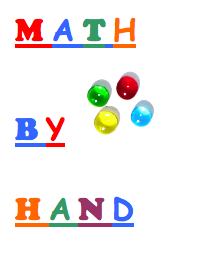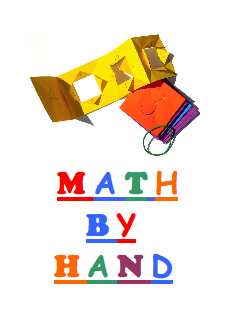 Cross-curricular integration is valuable with all subjects, but is especially important with math and language arts. Rhythmic recitation will enhance your homeschool math curriculum in many ways. Most importantly, the rhythmic element, essential to success in math, is strengthened by daily recitation. Classic poetry, songs, limericks. and especially jump rope and clapping verses are a great combination with math facts memorization.
Cross-curricular integration is valuable with all subjects, but is especially important with math and language arts. Rhythmic recitation will enhance your homeschool math curriculum in many ways. Most importantly, the rhythmic element, essential to success in math, is strengthened by daily recitation. Classic poetry, songs, limericks. and especially jump rope and clapping verses are a great combination with math facts memorization.
In the early grades, as skip counting is used for learning beginning times tables, you will find that a number of well-known songs and rhymes can be used as a perfect match. Holiday songs are a great example. Take for example, skip counting 2s to “Jingle Bells.”
Jingle bells, jingle bells, jingle all the way,
O, what fun it is to ride in a one-horse open sleigh.
Jin gle bells, jin gle bells, jin gle all the way,
2 4 6 8 10 and 2 times 6 is 12
O, what fun it is to ride in a one horse o pen sleigh.
14 16 18 20 22 24
It’s a good idea to accompany both the singing and the skip counting with movement, such as clapping or stepping in rhythm. Match the numbers to the words carefully, using their respective number of syllables correctly so they synch perfectly. Many familiar songs and verses can be used as helpful teaching aids that will greatly enhance your homeschool math curriculum!
As the higher tables are learned, clapping verses can be used as a fun lead in. A variety of clapping patterns (find some online or at the library) can be used with the verses and then as an accompaniment to skip counting the higher times tables. For example, Miss Mary Mack can be a lead in to the 6s.
Miss Mary Mack Mack Mack
All dressed in black, black, black
With tiny buttons, buttons, buttons,
All down her back, back back.
The rhythm of the numbers will find its own way of blending with the clapping rhythm. For example, with this simple pattern: clap hands together, clap partner’s hands, together, partner’s, etc., a very natural rhythm can be found to coordinate with the 6s (or any of the higher tables).
6 12 18 24 30 36 42 48 54 60 66 72
Daily recitation and/or singing, limericks, tongue twisters, etc. can help with many areas other than math. Memorization and recitation greatly improve speaking and writing skills, while they also provide self-confidence, better articulation, and a love of both the written and spoken word.
Make space in your homeschool day for recitation and singing, using the NCTE (the National
Standards for English) or your state’s language arts standards to document, assess, and apply the standards to these forms of literature as they correlate to math. Start the day with a math review that includes songs and poetry, and interweave rhythmic verses with all your homeschool math lessons. Many simple pleasures like these have been lost due to our hurried, modern lifestyles.
Your homeschool curriculum can provide the perfect antidote to this as you find and use lots of lively material while having some good, old-fashioned fun with it! You and your children can build stronger family and community ties while improving skills in many areas and on multiple levels. Add these tongue twisters and limericks to your homeschool curriculum, just for the fun of it. Find many more online or at your library!
Three free throws.
A box of biscuits, a box of mixed biscuits.
Six thick thistle sticks, six thick thistles stick.
Tim, the thin twin tinsmith.
Lovely lemon linament.
Flee from fog to fight flu fast.
A mouse in her room woke Miss Dowd.
She was frightened, it must be allowed,
Soon a happy thought hit her
To scare off the critter
She sat up in bed and meowed.
A funny young fellow named Perkins
Was terribly fond of small gherkins.
One day after tea,
He ate ninety-three
And pickled his internal workings.
First and foremost, please have fun with your homeschool math curriculum! It will pay many dividends, not the least of which is a love of math and a lifelong love of learning. Remember too, that happy students make better math students.
Tags: homeschool·homeschool math
 Should we be using a different measuring tool for intelligence? Dr. Howard Gardner, a professor of education at Harvard University, thought so. In 1983 he developed the theory of multiple intelligences, a measuring tool that allows for a multi-faceted look at the qualities and talents that comprise true intelligence. Your homeschool curriculum allows the flexibility of incorporating aspects of this theory into all of your lessons in all subjects.
Should we be using a different measuring tool for intelligence? Dr. Howard Gardner, a professor of education at Harvard University, thought so. In 1983 he developed the theory of multiple intelligences, a measuring tool that allows for a multi-faceted look at the qualities and talents that comprise true intelligence. Your homeschool curriculum allows the flexibility of incorporating aspects of this theory into all of your lessons in all subjects.
Using the multiple intelligence theory with your homeschool math curriculum is especially effective because math is often the most challenging subject to teach and learn. There are eight intelligences according to Dr. Gardner’s theory. You’ll find them listed below, with suggestions for how each one might fit your child(ren)’s learning needs and how to best integrate them into your math curriculum. Most children will often exhibit more than one of these!
Linguistic-Auditory Intelligence (“word smart”)
Your child loves to read, write, recite, and talk! S/he feels most comfortable curled up with a book or listening to or telling a story. Incorporate stories like “The Seven Swans” or “The Twelve Months” into first grade number recognition lessons. Clapping game rhymes like “Miss Mary Mack” could be a lead in to times tables practice in second or third grade math lessons. And word problems are an essential ingredient at all levels.
Logical-Mathematical Intelligence (“number/reasoning smart”)
Your child loves math! S/he is also good at problem-solving, recognizing patterns, and likes to conduct scientific experiments. Focus on the relationship between patterns and numbers, i.e., geometric forms and numbers, like the triangle and the number 3, the square and the number 4, etc. Use number “tricks” to encourage and enliven math practice, and point out patterns in the times tables, factors, etc. Relate math concepts to some of those science experiments!
Bodily-Kinesthetic Intelligence (“body smart”)
Your child is physically active and has excellent eye-hand coordination and dexterity. S/he loves hands-on activities, tends to remember by doing rather than hearing or seeing, and is very good at dance and/or sports. Liven up your math lessons with lots of physical movement like stepping and counting, first the numbers and then the times tables. Adapt vigorous games like leap frog or tag for effective math skills practice, and include lots of hands on activities like making “real” numbers with clay and other materials and using manipulatives to learn math concepts.
Musical Intelligence (“music smart”)
Your child enjoys singing and playing musical instruments, recognizes musical patterns and tones, and remembers songs and melodies well enough to sing or play “by ear.” S/he’s good at thinking in patterns, rhythms, and sounds. Relate music theory to math concepts, (i.e., scales’ and notes’ relationship to fractions). Have your musical student compose songs that are helpful learning aids for challenging math concepts such as learning the steps in long division.
Visual-Spatial Intelligence (“picture smart”)
Your child loves to draw, paint, put puzzles together, and interpret graphs, charts, and maps. S/he’s good at visualizing things and following or giving directions. Include art as an integral part of your math curriculum with colorful and imaginative illustrations of concepts and lessons. Use visual patterns like magic squares to teach factors and other number patterns. Teach with manipulatives as much as possible, i.e. color-coded columns for place value, coin rubbings to teach decimals and fractions using money amounts, and incremental, color-coded fraction pieces.
Interpersonal Intelligence (“people smart”)
Your child understands and interacts well with others, and is skilled at assessing their emotions, motivations, and intentions. S/he’s good at verbal and non-verbal communication, seeing things from different perspectives, resolving conflicts, and creating positive relationships. Your math curriculum should include lots of group activities like math-adapted games, cooperative problem solving, and group projects that use math skills like building, cooking, gardening, and crafts.
Intrapersonal Intelligence (“self smart”)
Your child is self-reflective and aware, good at assessing strengths and weaknesses, understands the basis for motivations and feelings. S/he’s a creative day-dreamer who also enjoys analyzing theories and ideas. Include lots of “back story” in your math curriculum: history and biography, like the origins of the modern measurement system (the king’s foot, the original word for mile, mille: a thousand paces), the history of number systems, and mathematicians’ life stories.
Naturalistic Intelligence (“nature smart”)
Your child loves exploring the great outdoors, and has a lively interest in all things in nature, like botany, biology, and zoology. S/he’s good at cataloging or categorizing information, and likes camping, gardening, and hiking. Imbue your math curriculum with multiple examples of how math appears in the natural world, such as the spiral in the sunflower and snail shell, the hexagon in the snowflake and honeycomb, and even the octagon in street stop signs! Combine your math lessons with gardening, a wonderful mix.
Integrating all these aspects into your homeschool math curriculum will not only insure that your child(ren) will be more engaged and interested in their math lessons, but that their interest will result in better retention, higher test scores, and a lifelong love of learning. Math, more so than any other subject, needs to be taught and learned with high-interest, versatile, and creative materials and methods!
Marin Lipowitz
Learning By Handz/Math By Hand
HomeSchool Math Curriculum
Tags:
Philip was a boy-wonder, a genius of sorts. At age 8, he masterminded several projects, at home and in the family van. One of these projects was a system that alerted Philip when visitors arrived at the front door. He devised a simple wiring configuration connecting the welcome mat to a red light bulb in his room that flashed a warning. Amazing!
Philip was one of my second grade charter homeschool students, and we had reached an impasse with regrouping in addition. Though he was able to come up with and engineer wonderfully creative and inventive projects, he was unable to grasp the concept of “carrying” numbers.
We tried something new on one of my home visits: I laid three large, felt color-coded columns side by side on the floor, and told Philip that each one of them represented 1’s, 10’s, and 100’s. Then I wrote an addition problem on a large piece of paper and supplied Philip with large numbered cards. This was the problem:
2 4 7
3 6 3
2 3 2
+________
Philip “copied” the numbers by placing each one on its appropriate column, so we had a duplicate of the problem on the columns on the floor. I also gave him smaller cards with number 1’s written on them, and then asked him to add up the 1’s column.
When he said “12” I told him to place the 2 at the bottom and asked him (as I indicated the smaller cards with the number 1) where he thought the 1 should go. The lights went on! Philip J-U-M-P-E-D to the top of the 10’s column and placed the “carrying” number there. He did the same with the 10’s and 100’s column, got the concept, was able to translate it to pencil and paper, and had no further problems with regrouping.
The kinesthetic approach works best for some, but it always helps to use large, colorful, and interactive materials when introducing new concepts. Concepts can be taught very concretely at first before translating them to their more abstract forms. 
Tags: homeschool math games
Playing games can be fun and math-friendly, and can help at any grade level to happily and painlessly hone math skills. Most classic, well-known games can easily be adapted for math practice. Buzz, Bingo, Tic-Tac-Toe, to name just a few, can be transformed into math skill-building versions. Have fun adapting some family favorites; here are a few to start with:
1-2-3 SPIDERWEB Grade 1 (counting, skip counting)
1) Wind bulky yarn (rainbow’s nice) or soft clothesline into a ball, tying a loop at the end.
2) Players (at least 5) sit cross-legged in a large circle with one of the players holding the ball.
3) That player starts by saying the first number, rolling the ball (while holding on to the looped end) to another player.
4) The yarn or rope is held by each player who then rolls the ball to the next player, while saying the next number.
5) Play continues until the ball is unwound and a “spiderweb” pattern is formed.
6) The ball is then rewound as the last player rolls the ball to the next to last player, following the pattern and either counting the same number sequence backwards or starting a new sequence.
1-2-3 BUZZ Grades 1 and up (counting, skip counting, times tables)
1) Players sit in a circle and call out numbers in turn.
2) Start by counting numbers in order up to 100.
3) Move on to skip counting 2s, 5s, and 10s up to 100 by saying the word BUZZ in place of those numbers (for 2s: 1-BUZZ-3-BUZZ-5-BUZZ, for 5s: 1-2-3-4-BUZZ-6-7-8-9-BUZZ, etc.
4) Begin with the lower and progress to the higher times tables as they are learned, by saying BUZZ in place of those numbers.
5) Anyone who misses a number or a BUZZ is out, and the last player in wins.
B-I-N-G-O Grades 2 and up (number recognition and ordering)
1) Use small squares of paper to write numbers 1-75 one on each square, with the following letters: 1-15/B, 16-30/I, 31-45/N, 46-60/G, 61-75/O.
2) Make a BINGO card for each of the players with 5 rows of 5 squares, with one of the letters in the word B-I-N-G-O written at the top of each column.
3) Each player chooses 5 random numbers from the groups for each letter, and writes them in the 5 spaces below that letter, in numerical order.
4) The center space (the 3rd one under N) is FREE.
5) Each player is given 25 markers (buttons, stones, glass gems).
6) The 75 numbered and lettered squares are placed in a bowl, and numbers are called, one by one.
7) The first player to spell BINGO, across, down, or diagonally, wins. Fill up all 25 spaces for an extra challenge!!
MAGIC SQUARE TIC-TAC-TOE Grades 3 and up (patterning and addition)
1) Draw 2 parallel vertical lines crossed by 2 parallel horizontal lines to create the classic 9-square Tic-Tac-Toe grid.
2) Assign the even numbers 2, 4, 6, 8 to one player, and the odd numbers: 1, 3, 5, 7, 9 to the other.
3) The player with odds goes first, placing one of the odd numbers in any square.
4) The other player does the same with one of the even numbers.
5) The object is to construct a vertical, horizontal, or diagonal row that adds up to 15.
6) The first player to do this wins, or the game ends in a draw when all squares are filled.
Favorite card games are fun to transform and play with as well. Math can be exciting and interesting, and playing games is a great way to keep math skills sharp!
Marin holds a Masters Degree in Waldorf Education, and a California teaching credential in art. She’s had years of experience as a Waldorf class teacher in the early grades, has taught hands-on science and math to homeschoolers in grades 1-6.
To read the original article click here> Homeschool Math Games
Tags: homeschool math·homeschool math games
 Cross-curricular integration is valuable with all subjects, but is especially important with math and language arts. Rhythmic recitation will enhance your homeschool math curriculum in many ways. Most importantly, the rhythmic element, essential to success in math, is strengthened by daily recitation. Classic poetry, songs, limericks. and especially jump rope and clapping verses are a great combination with math facts memorization.
Cross-curricular integration is valuable with all subjects, but is especially important with math and language arts. Rhythmic recitation will enhance your homeschool math curriculum in many ways. Most importantly, the rhythmic element, essential to success in math, is strengthened by daily recitation. Classic poetry, songs, limericks. and especially jump rope and clapping verses are a great combination with math facts memorization.

